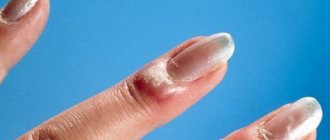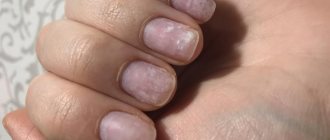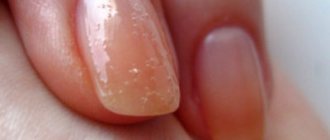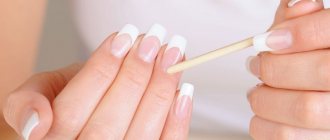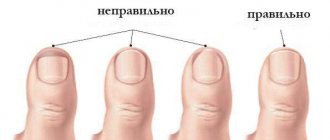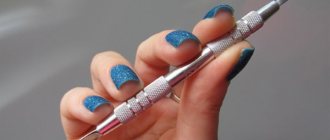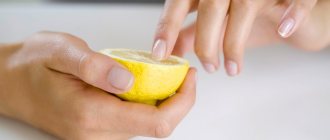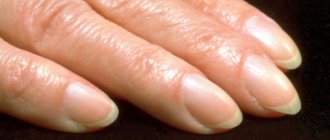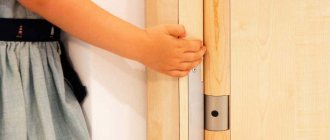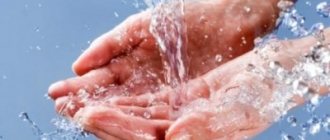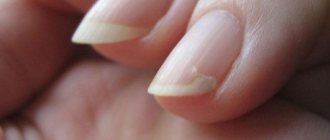Many women are interested in why hangnails appear. They can arise for various reasons. But the most common of them is improper manicure. Despite the fact that many people know about the advantages of unedged manicure, some women still prefer edged ones. Although it is in the case of trimmed manicure that most often burrs appear on the fingers.
Burrs as a result of trimmed manicure
As a rule, hangnails appear much more often after a trimmed manicure. This is due to a number of factors:
- it is possible that living skin was affected, although it is advisable to cut off only the keratinized cuticle. The affected areas become covered with wounds and begin to burn. At the slightest touch there is pain;
- Before proceeding with actual cutting, it is better to lubricate the skin around the nails with special oils. Due to this, it will become more tender, so the cuticle will be easier to cut. If you neglect this simple rule, then after the procedure, hangnails may appear, causing discomfort to the woman;
- The cuticle must be cut very carefully. This must be done so that it is removed in one go. Otherwise, a few days after the procedure, your fingers will become covered with many hangnails.
Cuticle – cut or move?
1. Move the cuticle as it grows:
— take oil for nail care, which can soften the cuticle and at the same time simplify your work;
- for direct mechanical impact on the cuticle, you can use the tool that is convenient for you (an orange stick, a rubber stick or a nail file, after all);
- move the grown cuticle closer to the base of the nail, do this with light movements;
- check if there are any hangnails around the nails, if there are any, cut them off;
- moisturize the skin of your hands with cream or oil so that your cuticles on your nails become soft.
2. Trim the cuticle as it grows:
- first you need to steam the cuticle very well so that it softens and becomes pliable: this can be done using a warm nail bath, to which various oils, mousses, and special cuticle products are added;
- move the cuticle to the base of the nail, as described above;
- It is very important which tool you use to trim the cuticle. These can be manicure scissors or tweezers, or a trimmer specially designed for this purpose.
It is important to do this procedure carefully and not to rush, otherwise you can damage the skin around the base of the nail and cause an infection there. Read all about Manicure at home here.
Of course, the most convenient way to do this is with a trimmer, but the main thing is that its edges are very sharp, then the result will be perfect.
“Fringe” hangnails after manicure! How to avoid?
Watch a very useful video on how to choose nail clippers.
Take care of your nails and hands, because when they first meet, many people pay attention to them!
Can burrs appear after an untrimmed manicure?
After an untrimmed manicure, there is also a possibility of burrs appearing. This can only happen if you do not adhere to all the requirements provided for this type of manicure. So, before you completely switch to it, you need to constantly nourish the cuticle with special oils. If you start doing it without oils, the skin may be too damaged.
In addition, most women polish their nails with a special file in the shape of a parallelepiped. If you are one of them too, then perform this procedure very carefully and at a slow pace. If you do it too quickly, the file can injure the skin around the nails.
Experts also recommend using only wooden sticks for bending cuticles.
They do this job carefully and do not injure the skin. But the sticks must be of high quality so as not to infect yourself with a splinter. These sticks are made from orange wood, so they have a hardness identical to a nail.
Wet cuticle, features of work
We will present to your attention instructions on how to work with it correctly and how to avoid mistakes. How to determine hyperhidrosis? It is necessary to look at the client's palms and fingertips; there is excess moisture on them. Among other things, when working with this type of cuticle, you must remember that it has an extremely sensitive matrix and must be handled extremely delicately. Wet cuticle is also called “creeping cuticle” or “sticky cuticle” and is quite difficult to lift. To do this, you need to use a diamond cylindrical cutter, and then clean it thoroughly from the surface of the nail plate using a diamond spherical nozzle. Since this type of cuticle is elastic, the cutter can slip or break the skin.
Let's describe the whole process step by step:
- First you need to dry the skin using a dehydrator. Then use a pusher to gently move the skin in the direction of the phalanx.
- Then, using a fissure cutter, carefully clean the pterygium from the surface and slightly lift the cuticle. It is important not to open it, but rather to lift it, separating it from the nail plate. This is done in order to evenly cut the cuticle with nail scissors.
- After the cuticle is cut, the surface must be sanded, removing roughness and remnants of the pterygium. It is best to perform this operation with a corundum “cone” attachment; the optimal speed is 5000-7000 rpm.
- After the surface has been sanded, it is necessary to remove the inner and outer parts of the cuticle; this is done using a ball-shaped diamond cutter. Clean off the residue using gentle upward and sideways movements, trying not to touch the nail with the cutter to avoid damaging the surface of the plate. Use the same movements to process the side roller. As for burrs, they must be removed in the opposite direction from their growth - using gentle, cutting movements, try not to press too hard on the cutter.
- Final grinding must be done with the softest possible corundum attachment in the shape of a ball. Apply light, long strokes to the skin around and under the nail. This will eliminate roughness and cut residues, and also add a beautiful shine. Attention, in order not to burn the client’s skin, the cutter must constantly move; under no circumstances linger on one area.
- After sanding, use a brush and a damp cloth to carefully remove the sawdust. Using a pusher, give the cuticle a rounded shape. Next, apply the decorative coating according to the standard scheme.
So, we have outlined simple rules for working with wet cuticle; as you can see, manual and hardware processing techniques are perfectly combined and complement each other. We hope the instructions presented will help you avoid unnecessary mistakes.
Hangnails after gel manicure
Recently, gel-based manicure has gained immense popularity. However, it can negatively affect not only the nails, but also the skin adjacent to them. The procedure is quite lengthy and consists of several stages. By the way, burrs can appear due to any of these stages if you do not have a very good master.
First, the surface of the nails is coated with a special product that degreases the nail. But some manicurists use regular alcohol or nail polish remover for this. Both the first and second drugs dry out the skin greatly. As a result, hangnails may form after a manicure. But that is not all.
Next you need to polish the nail for better adhesion to the gel. For this, very hard files are used.
If the master polishes the nails very quickly, pressing hard on them, then there is a possibility that the skin will be damaged.
Also, the gel applied to the nails does not dry out on its own. For this to happen, your hands need to be placed in a special UV lamp. However, such a device may not be suitable for everyone. Some women complain that after the procedure, the skin of their hands begins to peel, which is due to the negative effects of ultraviolet rays. If you hold your hands under the lamp for too long, this pathology may also appear.
No less dangerous is the correction of gel nails. Indeed, in this case it is necessary to remove the previous layer of gel. For this purpose, the nails are carefully polished, so the skin is touched. Some people use special products to remove the gel layer, which also lead to severe drying of the skin.
Who is to blame: why do burrs appear?
Hangnails in a child are normal. There he rummaged in the sandbox, here he tinkered with plasticine, and secretly sucked his finger and chewed his nails. All this dries out the skin, reduces its elasticity, leads to the formation of cracks and tears - and, as a result, to the appearance of hangnails. But why do hangnails appear in adults who take care of the beauty of their nails without sparing their wallets?
Household attack
Although modern apartments are packed with turnkey appliances, you have to deal with everyday life, and the result of the interaction on your hands can be the most disastrous. Housework with chemicals (cleaning powders, dishwashing gels and even delicate balms for washing lace underwear) without gloves dries out the skin, and dry skin is fertile ground for hangnails.
Vitamin deficiency
“Fringe” around the nails may be a consequence of a deficiency of vitamins - mainly A and E. And the reason sometimes does not lie in a meager menu. Absorption of nutrients is affected by problems with the gastrointestinal tract. Even if you eat caviar with spoons, not a single vitamin will be absorbed.
Office work
What does “clean” office work have to do with hangnails? Direct. Frequent contact with paper causes the skin of your hands to dry out. Paper, like a sponge, absorbs fat and moisture.
Manicure
Hangnails after manicure –
how can this be? Easily. If we are talking about a trimmed manicure, there is a high risk of injuring the skin near the nail; with an untrimmed manicure, there is a high risk of pushing the cuticle too deep or drying it out with an alkaline solvent.
Air conditioning, heating, insufficient fluid intake - these are a number of other reasons why the delicate skin around the nail plate dries out and tears. We know why. We'll find out what to do.
Are hangnails scary?
Most women don't even think about why they get hangnails. They continue to do manicures without adhering to all the requirements, without paying due attention to them. But pain due to hangnails is not the worst thing. They can lead to various complications. Infections and inflammation may appear. It is especially dangerous to have a manicure done by a manicurist who uses his own set of tools in the process. After all, no one knows whose nails he decorated before you. Therefore, it is better to purchase everything you need to perform a manicure yourself to be sure that only you use it. Various fungal infections can be transmitted through hangnails.
Of course, you can't leave them on their own. But you shouldn’t cut them off, as many do. This can cause severe pain, and the likelihood of infection increases even more. Therefore, if you have hangnails, they need to be disinfected 2-3 times a day to avoid infection. To do this, it is better to use hydrogen peroxide, which dries the skin less than alcohol.
If after a manicure you begin to develop hangnails, then you need to think about it. This means that his technique does not meet all established requirements. If the procedure is performed by a master, it is recommended to find another one. If you do your own manicure, then study again exactly how to do it.
How to avoid the appearance of burrs?
To prevent the appearance of burrs, you just need to follow a number of simple rules:
- Drink at least 2 liters of water throughout the day.
- Diversify your diet. Include as many foods that contain vitamin A as possible.
- After each hand washing, dry them thoroughly with a towel.
- Wear rubber gloves while doing household chores.
- Always use hand cream.
- During the cold season, do not go outside without mittens.
How to avoid burrs
Most often, women themselves provoke the appearance of hangnails on their fingers, while the ladies do not even notice it. To avoid encountering such an unpleasant problem, never do the following:
- Do not cut the cuticle very deeply - this will cause tears in the skin of the nail fold.
- If you notice a hangnail on your finger, do not try to tear it off or bite it off. Otherwise, severe inflammation will occur,
If there are a lot of hangnails on your fingers, be sure to seek help from a manicurist. A specialist will solve the problem by doing a hardware manicure. Of course, you won’t be able to forget about the problem in one visit, but several sessions will give a positive result.
Complications
If you think that hangnails are a harmless phenomenon, then you are mistaken.
Like any damage to the skin, hangnails can become a gateway for infectious agents of bacterial (streptococcus, Staphylococcus aureus, Pseudomonas aeruginosa) and fungal (dermatophytes, candida) infections.
Post Views: 1,174
